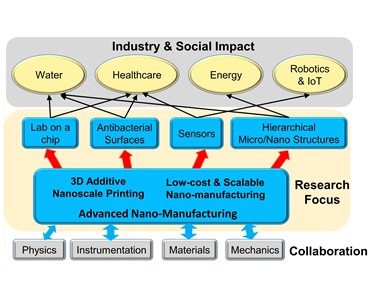Lab Vision and Research Projects
Our lab focuses on developing novel nanomanufacturing methods, seeking inspiration from nature to provide solutions to challenging issues in healthcare, environment, and energy. Our lab is centered on nanomanufacturing technology because it is the cornerstone of nanotechnology crucial for the successful application of nanotechnology to the real world. Our lab is an interdisciplinary lab and we work with researchers from biology, mechanics, instrumentation, physics, and material science for inventing truly innnovative technology.
Our research covers tip-based nanofabrication, scalable nanofabrication methods, bio-inspired antibacterial surfaces, lab on a chip, and advanced sensors for small particulate matter detection such as PM 2.5 and even smaller particles.

Students who go through the vigorous academic education in our lab will develop the capability of innovation through working in a multi-cultural and interdisciplinary research environment. Ph.D students from our lab will be encouraged to pursue postdoc positions for academic career paths or join industry for real-world applications.
Current on-going projects are listed blow:
1. Low-cost and real-time particulate matter (PM) sensing using micro/nano chips. (Dustin and Sam)
PM concentration monitoring is crucial for human health. A low-cost, portable, real-time monitoring device can allow users to evaulate their exposure risk in their local environment, identify hazards in working conditions. These devices can also be useful for monitoring outdoor air condition for HVAC system to work efficiently in buildings.
The first part of a PM monitor is to pass the particulate containing air through a classification stage to separate PM 2.5 and PM 10 from other sized particles. The separation method is based on the exponential increase of particle mass therefore the inertial force as the particle diameter increases. Impactor, virtual impactor and cyclone are the three typical separation devices.
The second part is to detect the particles. Generally, mass measuring on a filter is used as the standard. Alternative method includes a tapered-element oscillating microbalance or a quartz crystal microbalance (QCM). Attachment of particles on the oscillating structure causes a drift in resonating frequency, providing a time-integrated mass measurements. Opitcal measurements are the most common methods for particle measurement.
2. Nanomaterials for particulate matter filtering (Han, Otto and Stephen)
3. Driver fatigue sensing (Teddy and Bill)
